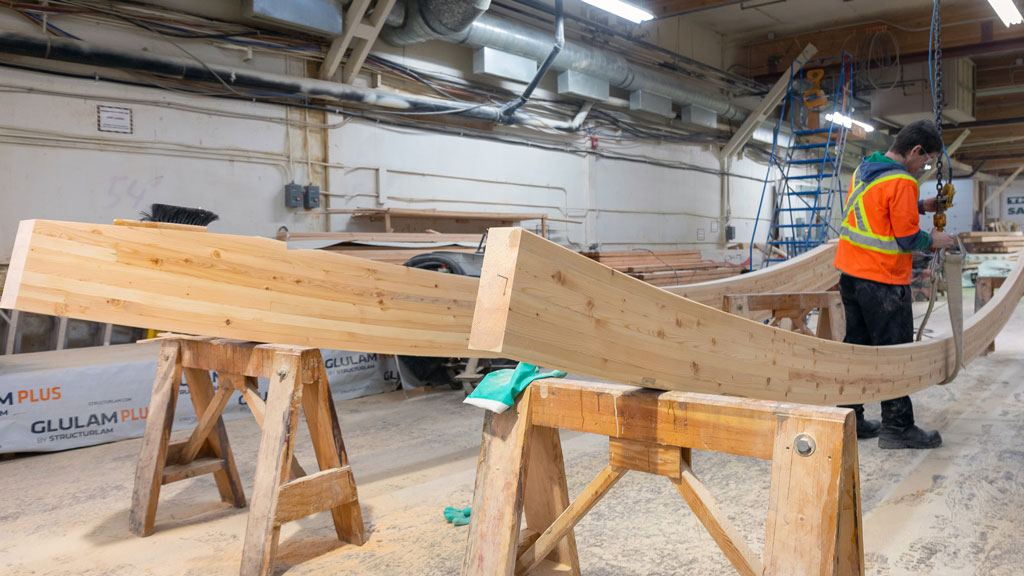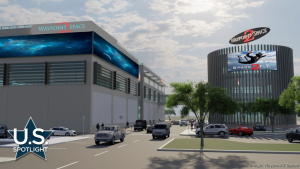The mass timber market has never been stronger, with the number of mass timber buildings doubling globally every two years, but the head of Canada’s pioneering timber firm Structurlam says there are still substantial hurdles for the sector to overcome for it to achieve its potential.
Structurlam CEO Hardy Wentzel has announced that the Penticton, B.C.-based firm is close to commissioning its first U.S. plant, in Conway, Ark. The new 287,000-square-foot facility will produce glulam and CLT, just as Structurlam’s existing three plants in Penticton do, but the U.S. site will have double the production capacity of the Canadian plants.
Structurlam’s combined facilities will now be capable of producing three 200,000-square-foot mass timber buildings per month.
Wentzel said recently that as both the U.S. and Canadian governments pursue green building goals as part of their efforts to achieve their Paris climate commitments, the mass timber sector is well positioned to become essential suppliers.
“The stars are aligned for us,” said Wentzel, a 40-year veteran of the timber sector. “In Conway, the U.S…climate-smart forestry is the buzzword these days. I like to refer to climate-smart construction.
“Both countries are well poised to really do well in mass timber. We have a building-with-wood culture, more so than anywhere else in the world.”
Structurlam has been in operation almost 60 years and already sells its products across the continent but the new plant in Arkansas will provide a central location to reach more potential North American customers, Wentzel said. Arkansas has a high-quality southern pine wood basket, is within 800 kilometres of 16 of the 50 largest cities in the U.S. — and it allows better access to Eastern Canada.
“I’m actually closer to the Toronto market from Conway, Arkansas, by about 1,200 miles than I am from Penticton, British Columbia,” Wentzel said.
On the regulatory side, the National Building Code supports 12-storey mass timber structures but there are variations among provincial codes. British Columbia embraced the mass timber market more quickly than Ontario did and its building code permits 12 storeys “as of right” while in Ontario projects above six storeys require extra engineering certification.
Marianne Berube, executive director of Ontario’s Wood WORKS!, said Ontario is looking at adopting the national code standard of 12 storeys in 2022 or 2023.
“The sweet spot for midrise mass timber construction will be seven to 10 storeys,” Berube said. “FPInnovations market studies have predicted this for a few years. It addresses urban densification needs and making it more affordable for housing and office space. With the price of land in many large urban centres, five to six storeys isn’t viable and we have to build higher.”
Wentzel’s firm contributed to the construction of the University of British Columbia’s 18-storey Brock Commons Tallwood House but he also used the term “sweet spot” in suggesting that mass timber will eventually be used primarily in the eight- to 12-storey range.
“I think we need to be also mindful that this doesn’t need to be a space race,” said Wentzel. “When I say that I mean, there’s a lot of people out there trying to push the limits of mass timber, they go into 30-storey buildings and super-high skyscrapers. That’s OK but the nuts and bolts are in this eight to 12 range.”
Wentzel believes the next barriers to overcome in the sector are not height regulations but rather the mindsets of stakeholders such as insurers and contractors.
“Insurers have to get with the times,” said Wentzel. “Contractors who are used to using concrete and steel for 12-storey buildings have to reprogram themselves and start thinking of using these lighter, faster, higher-quality materials like mass timber.”
He acknowledged progress is being made on all fronts, with agencies like the Canadian Wood Council working to increase awareness of the safety of wood within the insurance industry and substantial innovation being displayed by architects.
In the end, Wentzel said, it is consumers who will drive acceptance of mass timber in the industry.
“We’re seeing a lot of new entrants into the space because architects and engineers are adopting mass timber technology in their construction plans, building owners and developers are getting requests from consumers who use their product, who will ultimately live, work and play, and…developers are requesting more sustainable options. So you have consumerism also working positively around being more sustainable,” he said.
Follow the author on Twitter @DonWall_DCN.











Recent Comments